Products: Mango
Tommy Atkin
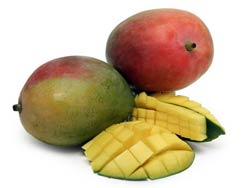
Tommy Atkins is a mango cultivar. Although generally not considered to be the best in terms of sweetness and flavor, it is valued for its very long shelf life and tolerance of handling and transportation with little or no bruising or degradation. This means it is the main mango sold in regions where mangoes have to be imported, comprising about 80% of mangoes sold in the United Kingdom and United States, apart from growing regions in California, Hawaii and Florida. However, in France it is sold at a discount, while the main imported cultivar is Kent, considered less fibrous and tastier.
Kent
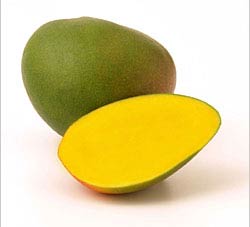
Kent mango has an ovoid-wide fruit. The yellow skin with red spot. The average weight of these fruits on a full loaded tree is 470 to 550 grams. The flesh has little fiber and it is very good to eat with the spoon. Small seed size. It has an excellent eating quality and long shelf life. It has an upright growth and moderate vigorous tree.
Irwin
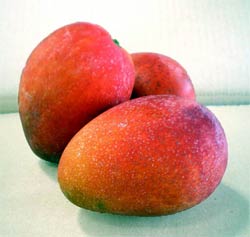
The original 'Irwin' tree was a seedling of the 'Lippens' cultivar that was open-cross pollinated with 'Haden', planted on the property of F.D. Irwin in Miami, Florida in 1939. The tree first bore fruit in 1945 and was named and described in 1949. The fruit gained commercial acceptance due to its good production, flavor, relative disease resistance, and attractive color. 'Irwin' has also been sold as a nursery stock tree for home growing in Florida. Today 'Irwin' is grown on some commercial scale in a number of countries, including Japan, Taiwan, and Australia, where it was introduced in the 1970s. 'Irwin' trees are planted in the collections of the USDA's germplasm repository in Miami, the University of Florida's Tropical Research and Education Center in Homestead, Florida, and the Miami-Dade Fruit and Spice Park, also in Homestead. 'Irwin' fruit is of ovate shape, with a rounded base and a pointed apex, lacking a beak. The smooth skin develops an eye-catching dark red blush at maturity. The flesh is yellow and has a mild but sweet flavor and a pleasant aroma. It is fiberless and contains a monoembryonic seed. The fruit typically mature from June to July in Florida and is often born in clusters. The trees are moderately vigorous growers capable of exceeding 20 feet in height if left unpruned, developing open canopies.
Osteen
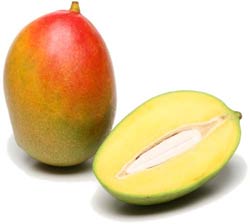
The original tree grew from a seed planted in 1935 on the property of S.A. Osteen, the first County Commissioner of Brevard County, Florida. 'Osteen' was reportedly a seedling of 'Haden', which pedigree analysis later supported. The tree first fruit in 1940 and was named after the well known Osteen family that lived in the Lotus subdivision on South Tropical Trail in Merritt Island, Florida since the late 19th century. The descendants still live there to date. 'Osteen' was evaluated for commercial use and later adopted as a commercial cultivar due to its color, production characteristics, and flavor. Today it is a favored cultivar in Europe and is still grown on a small commercial scale in Florida on Merritt Island. 'Osteen' trees are planted in the collections of the USDA's germplasm repository in Miami, Florida and the Miami-Dade Fruit and Spice Park in Homestead, Florida. The fruit is of oblong shape with a rounded base and apex that sometimes contains a small beak. It averages a little over a pound in weight at maturity. The smooth skin has a yellow background color but usually turns dark purple. The flesh is nearly fiberless and has a mild yet sweet flavor. The fruit contains a monoembryonic seed. It typically matures from July to September in Florida. 'Osteen' trees are vigorous growers and produce dense canopies.
Palmer
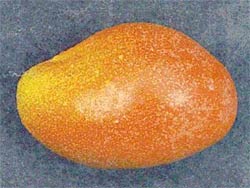
The original tree was grown from a seed planted around 1925 on the property of Mrs. Victor Mell of Miami, Florida. For the following decades 'Palmer' 's parentage was unknown, however a 2005 pedigree analysis estimated 'Palmer' was a seedling of 'Haden'. The variety was first propagated in 1945 and officially named in 1949. It gained some commercial acceptance in Florida and is still grown on a limited commercial basis in the state today, as well as areas outside the United States such as Africa and Australia. 'Palmer' trees are planted in the collections of the USDA's germplasm repository in Miami, the University of Florida's Tropical Research and Education Center in Homestead, Florida, and the Miami-Dade Fruit and Spice Park, also in Homestead. The fruit is large, with especially big specimens reaching several pounds in weight. Coloration tends to be yellow with red blush when ripe; the fruit will turn purple long before becoming mature, sometimes leading to immature fruits being picked. The flesh is orange-yellow and has a mild and aromatic flavor, with minimal fiber, and contains a monoembryonic seed. It ripens from July to early September in Florida, making it a late-season cultivar. 'Palmer' trees are moderately vigorous growers and have upright canopies.
Van Dyke
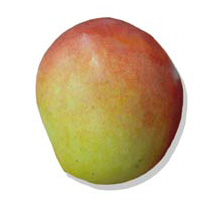
The original tree grew from a seed likely planted in the 1930s on the property of Mrs. Madeline Van Dyke in Miami, Florida. For decades the parentage of 'Van Dyke' was unknown, though a 2005 pedigree analysis estimated that 'Haden' was the likely parent. The tree began fruiting in the 1940s and was found to have enough potential to be propagated during the 1950s, and by 1955 the Flagg Brothers Nursery had sold several hundred trees. That same year 'Van Dyke' was submitted to the Florida Mango Forum for evaluation. 'Van Dyke' was recognized for its superior color and eating quality, and limited commercial plantings began in the 1960s and increased over the following two decades. Its commercial potential was considered limited in Florida due to the fruit's relatively small size and susceptibility to internal breakdown, but 'Van Dyke' was later introduced to Brazil and eastern Africa and found commercial success being exported to Europe. Today 'Van Dyke' is still sold as a nurserystock tree for home growing in Florida, and is grown on a small commercial scale. 'Van Dyke' trees are planted in the collections of the USDA's germplasm repository in Miami, the University of Florida's Tropical Research and Education Center in Homestead, Florida, and the Miami-Dade Fruit and Spice Park, also in Homestead.
Maya
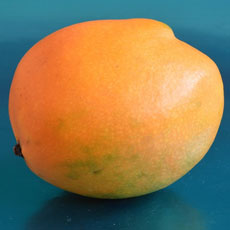
Maya is a high quality mango with a lovely flavour and smooth, fibreless flesh. The shape is quite round compared to many mangoes, and a distinctive feature is a small prominent 'horn' at the stylar end. ... Maya is a beautiful mango with silky smooth flesh which will be thoroughly enjoyed by consumers.
Keitt
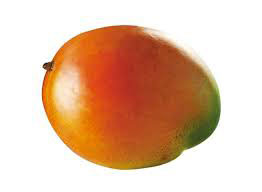
The fruit is comparatively large, some reaching up to several pounds in weight. They are of ovoid shape with a rounded apex lacking a beak. The skin color is typically green with some light red blush. The flesh has fibers, tangy and sweet, with a monoembryonic seed. The fruit generally has good disease resistance, and typically ripens from August until September in Florida,[9] often into October as well, making it one of the more valued late-season varieties..
Kenigston
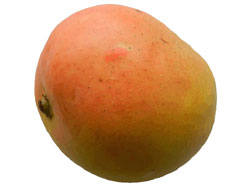
The fruit average around a 500 grams in weight at maturity. They are ovate in shape and have a rounded apex, generally lacking a beak. The skin color is yellow, developing some red blush. The flesh is yellow, with moderate fiber, and has a sweet and spicy flavor. The fruit contains a polyembryonic seed, meaning that two seedlings emerge from one seed.






